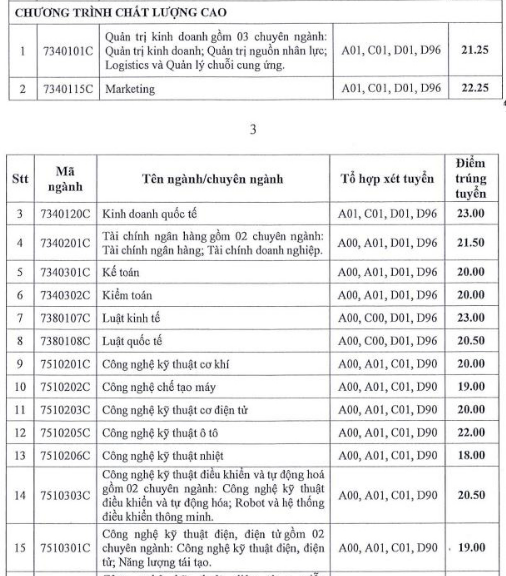Cut-offs of Ho Chi Minh City University of Industry in 2023
Cut-offs of Ho Chi Minh City University of Industry in 2023
On August 23, 2023, Ho Chi Minh City University of Industry issued Announcement 956/TB-DHCN of 2023 on the publication of the University of Industry's Cut-offs for 2023.
>> View Announcement 956/TB-DHCN of 2023: Download
The University of Industry's Cut-offs for 2023 are as follows:







Cut-offs of Ho Chi Minh City University of Industry in 2023 (Image from the Internet)
How to Calculate Bonus Points for Admission to Ho Chi Minh City University of Industry in 2024?
As stipulated in Appendix I issued together with Circular 08/2022/TT-BGDDT and Article 7 of the University and College Admission Regulations in the Early Childhood Education sector issued together with Circular 08/2022/TT-BGDDT, the method for calculating bonus points for admission to Ho Chi Minh City University of Industry in 2024 by region is as follows:
bonus points for candidates with a total score of 22.5 or higher (when converted to a 10-point scale and a maximum of 30 points for 3 subjects) are determined according to the formula:
Bonus points = [(30 - Total Score Achieved) / 7.5] x bonus point Level
In which, the bonus point levels corresponding to the total score of 3 subjects (in the selection combination) on a 10-point scale for each test/subject (without multiplying factors); if the admission method uses a different scale, the bonus point level is equivalently converted.
Specifically: the bonus point levels are as follows:
| Region | Description and Conditions for the Region |
| Region 1 (KV1) +0.75 points | Communities in regions 1, 2, 3, and communities with particularly difficult villages in ethnic and mountainous areas; particularly difficult coastal and island communities; particularly difficult communities, border communities, safe zone communities under the investment program 135 as defined by the Prime Minister of the Government of Vietnam. |
| Rural Region 2 (KV2-NT) +0.5 points | Localities not in KV1, KV2, KV3; |
| Region 2 (KV2) +0.25 points | District-level towns and cities directly under provincial management; district-level towns, suburban districts of cities directly under central management (except for communities in KV1). |
Additionally, candidates in inner districts of cities directly under central management will not receive bonus points.
Vietnam currently has five centrally managed cities: Hanoi, Ho Chi Minh City, Hai Phong, Da Nang, Can Tho.
Note: The admission area of each candidate is determined by the location of the school where the candidate studied the longest during their high school (or intermediate) education; if the study period (longest) in the areas is equal, the area of the last school attended is considered.
Basic Principles in Admission to Ho Chi Minh City University of Industry in 2024
Based on Article 4 of the University and College Admission Regulations in the Early Childhood Education sector issued together with Circular 08/2022/TT-BGDDT, the basic principles in admission to Ho Chi Minh City University of Industry in 2024 can be determined as follows:
- Equity for Candidates
+ In providing information: Each interested candidate is provided with full, clear, reliable, consistent, and prompt information to make a suitable decision and best prepare for participation in the admission process;
+ In admission opportunities: No candidate is deprived of admission opportunities due to regulations unrelated to qualifications, competency (except for special regulations of the Ministry of Public Security and Ministry of Defense in the fields of defense and security); or due to cumbersome, time-consuming admission processes;
+ In competency assessment: Candidates must be assessed objectively, fairly, and reliably in terms of academic capability and potential for success to meet the requirements of the program and training sector;
+ In admission opportunities: Candidates should be given the highest admission opportunities and the right to determine priority desires among eligible programs and training sectors;
+ In fulfilling commitments: Training institutions must fulfill their commitments to candidates; provide advice, support, and resolve complaints, protecting the legitimate rights of candidates in risk situations.
- Equality Among Training Institutions
+ In cooperation: Training institutions cooperate equally to improve the quality and efficiency of admissions, while also bringing the best benefits to candidates;
+ In competition: Training institutions compete honestly, fairly, and healthily in admissions according to the legal regulations on competition.
- Transparency to Society
+ In information transparency: Training institutions are responsible for publicly disclosing full, clear, and prompt admission information through appropriate media channels for society and state management agencies to monitor;
+ In accountability: Training institutions are responsible for reporting as required by state management agencies and explaining to society through appropriate forms about major issues causing public concern.

